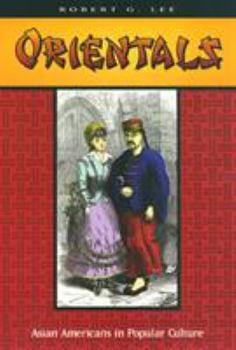Orientals
Select Format
Select Condition 
Book Overview
Sooner or later every Asian-American must deal with the question "Where do you come from?" It is probably the most familiar if least aggressive form of racism. It is a tip-off to the persistent notion... This description may be from another edition of this product.
Format:Paperback
Language:English
ISBN:1566397537
ISBN13:9781566397537
Release Date:October 1999
Publisher:Temple University Press
Length:288 Pages
Weight:0.85 lbs.
Dimensions:0.7" x 6.0" x 8.9"
Customer Reviews
2 ratings
Popular Culture and the History of Racism
Published by Thriftbooks.com User , 23 years ago
Robert G. Lee eloquently and effectively illustrates how the construct of race in America operated to perpetuate racist notions towards Asian American immigrants. The history of ascribed racism towards Asian Americans had its roots in the mid 19th Century, and it operated under an American system of placing cultural meaning on the body. Racist notions toward Asian Americans were created chiefly to solidify the American sense of nationality and cohesion that was absent, and needed in order to facilitate American identity. Lee examines how racist ideas were perpetuated and transmitted through popular culture in the "six faces of the Oriental," the pollutant, the coolie, the deviant, the yellow peril, the model minority, and the gook. These caricatures implied that all Asian Americans fell in to one of six categories, and this stereotyping precluded most Asian Americans from functioning as individuals in American society. Systematic "typing" of the Asian Americans in America, Lee argues, functioned to maintain systems that were larger and more socially driven. These complex social practices were not lost on many Asian Americans, however, and many Asian Americans consistently challenged the unfair ideology of a nation that at once promoted individuality while denying the right to that individuality though six invariable types. Lee cleverly illustrates how each of the six types gave meaning to the Asian body by showing how each stereotype functioned at different periods in America's history. America's first encounter with the Asian Americans quickly led to the idea that they were "pollutants" in their religious practices, or were, as Lee calls them, ""Heathen Chinee' on God's Free Soil." The alien body of the Asian American subsequently served as a system of white working class identity in the "coolie." As "deviants," the Asian Americans challenged not only racial but gendered ideas as well, and the forced prostitution of Chinese women prior to arriving to America led them to become a sexualized threat. Apparent as threats to Victorian ideas of domesticity and gentility, sexuality perpetuated the Chinese women' subservience not only to men but women as well. As the "yellow peril" Asian immigrants represented a larger anxiety towards all immigrants. Lothrop Stoddard's 1920 publication, The Rising Tide of Color was a pseudo-scientific rally to abort Asian immigration, claiming that the Asian immigrants were a racial threat to American society and thus their presence was indeed a "peril." The "model minority" during the Cold War functioned through the financial success of the Asian immigrants, establishing them as a veritable consumer market. The "model minority" gave birth to the "gook," which was actually a response to America's eventual de-industrialization after the Cold War. At this point, according to Lee, America continues to racialize Asians as "Orientals," through allusions to the previous six typecastings as well as newer forms of
Identity and Association
Published by Thriftbooks.com User , 24 years ago
This text is an interesting overview to the constant redefinition that society has in creating and labeling the term "Asian". I do not believe that the author chose to title the book "Orientals" as a derogatory term, rather as a word that has been misconstrued within western ideology. The title itself brings attention to the constant shift and misrepresentation of Asians within Westernized culture. Being Asian American alone is no longer enough it seems within society. Most individuals currently label themselves as Filipino-American, Vietnamese-American, Korean-American, Indian-American, etc. The whole notion of how a large group such as Asians identify themselves nowadays is too large, and complicated of a subject to discuss in a literary commentary such as this one. I do admit that word "Orient" is a term that has been used to label goods and products; it is a term that misrepresented whole nations of people. But one has to remember too that its origins derive from a period and society that considered people of color, and foreign locals as "goods" rather than people or individuals. In reference to this text, it is an informative text but not one of the best published. I would suggest Fanon, (Stuart) Hall, Spivak, and Trinh if one were interested in searching about Diaspora and identity.






